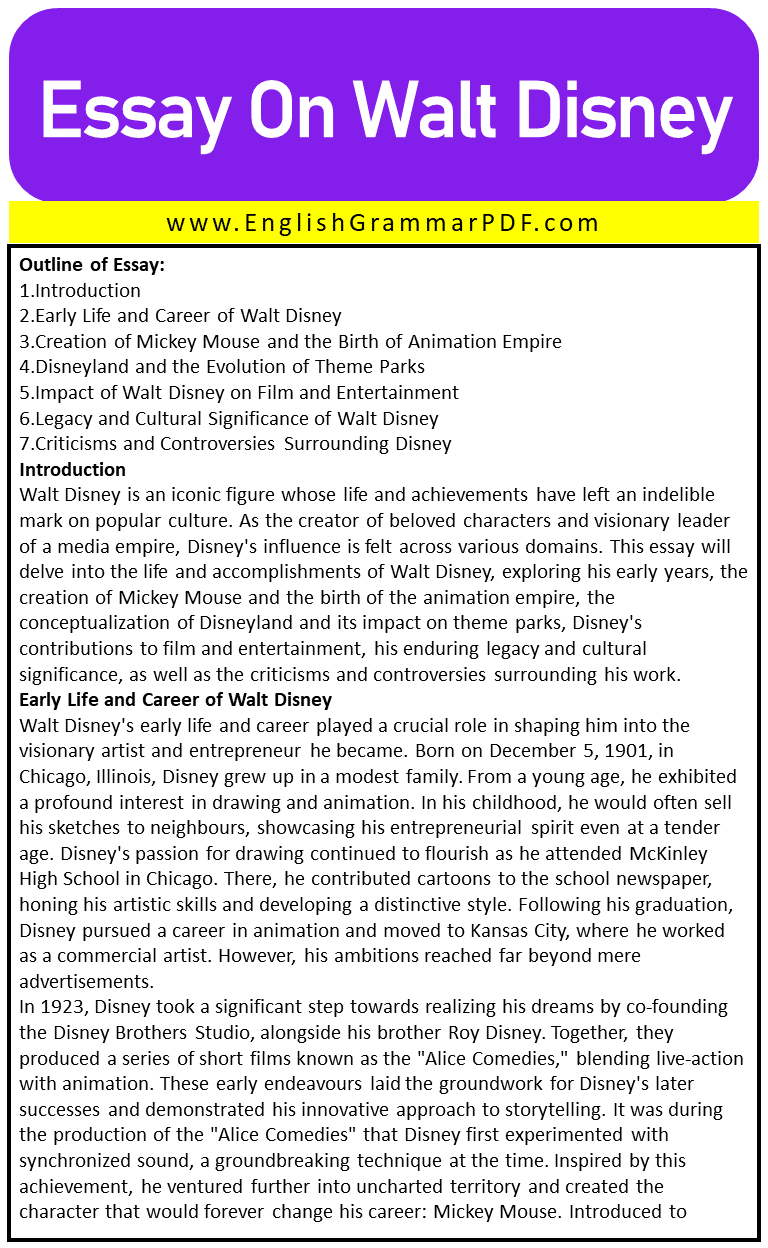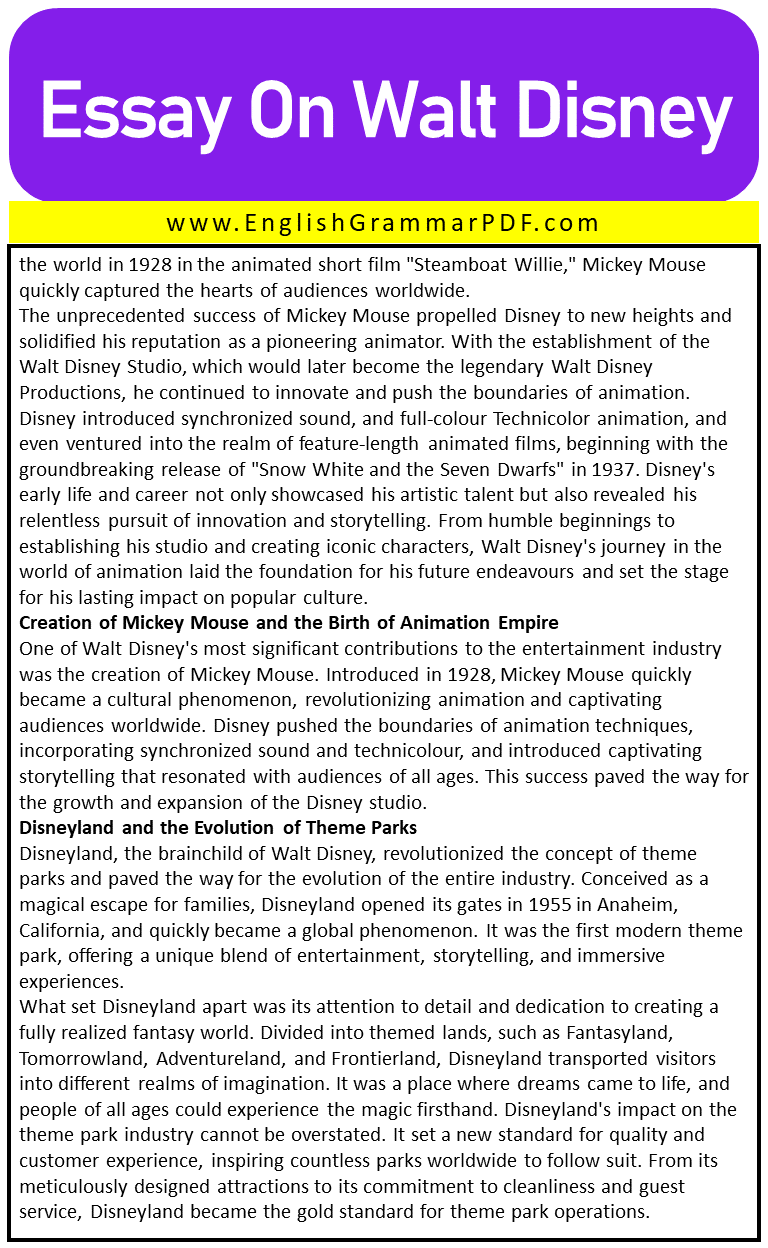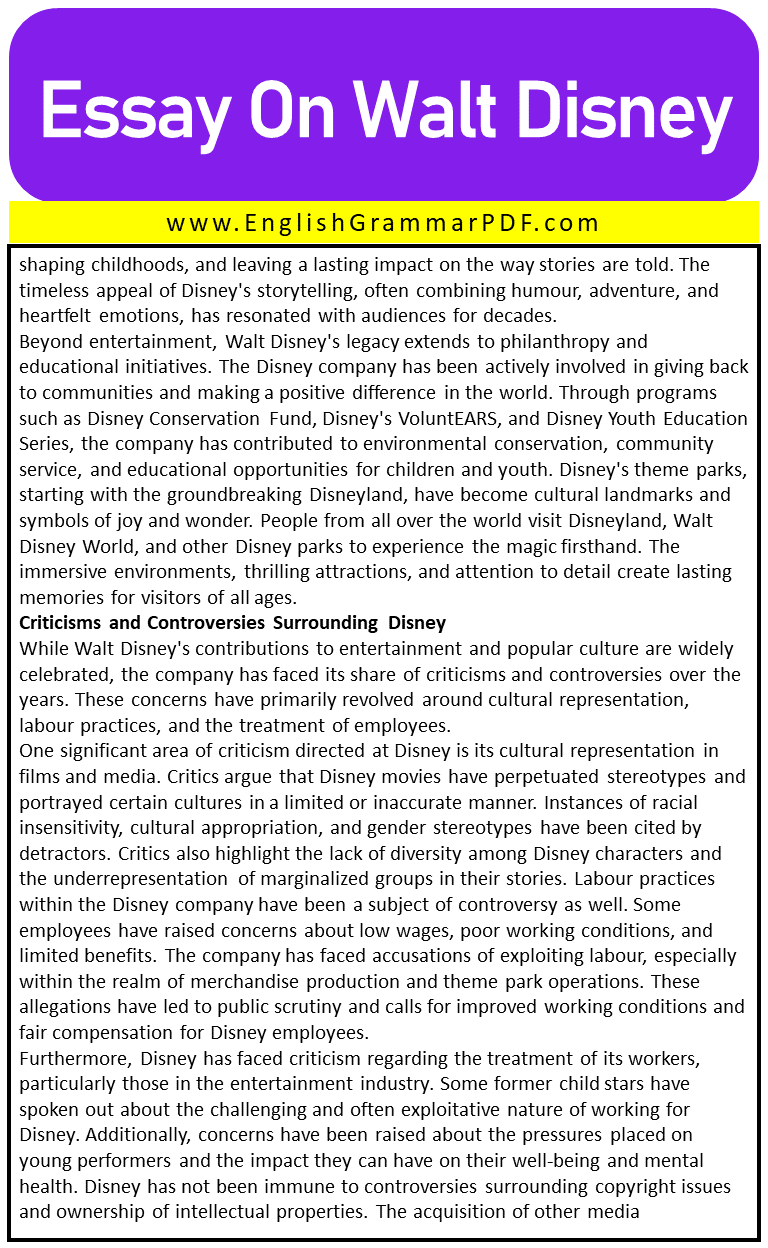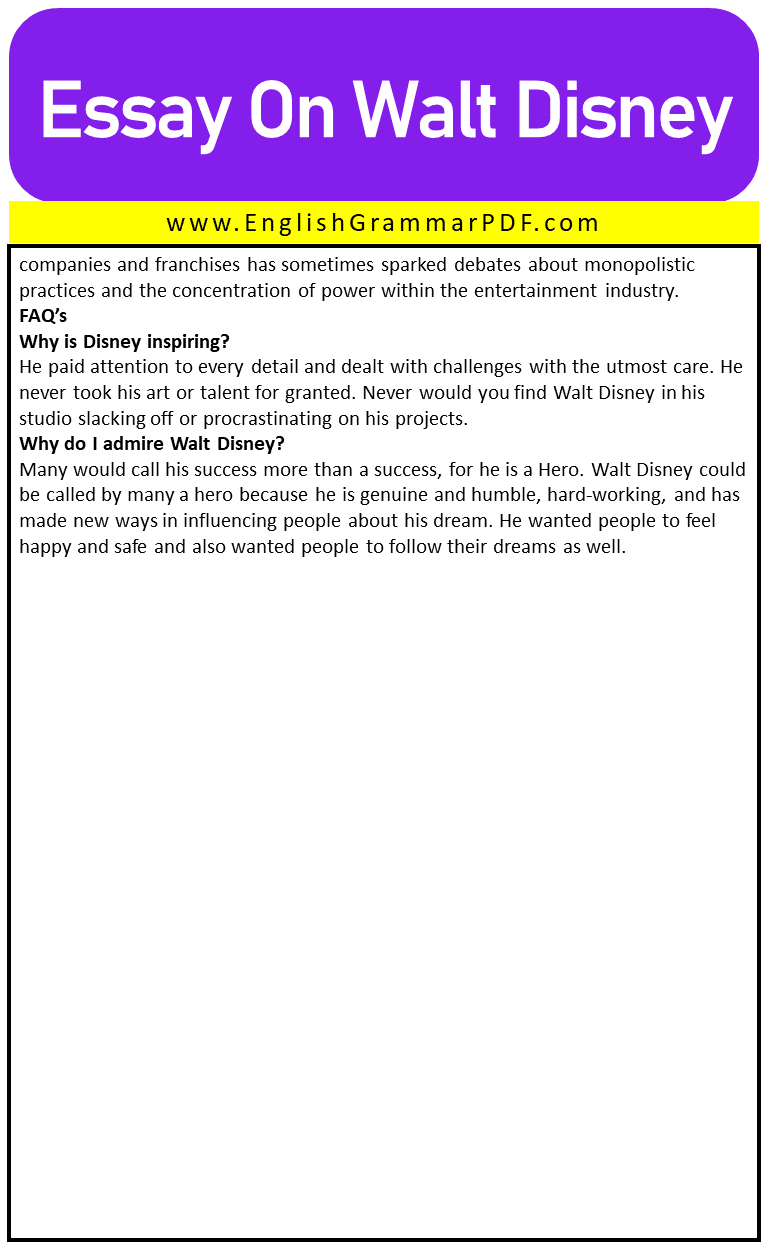Essay On Walt Disney
Outline of Essay:
- Introduction
- Early Life and Career of Walt Disney
- Creation of Mickey Mouse and the Birth of Animation Empire
- Disneyland and the Evolution of Theme Parks
- Impact of Walt Disney on Film and Entertainment
- Legacy and Cultural Significance of Walt Disney
- Criticisms and Controversies Surrounding Disney
Introduction
Walt Disney is an iconic figure whose life and achievements have left an indelible mark on popular culture. As the creator of beloved characters and visionary leader of a media empire, Disney’s influence is felt across various domains. This essay will delve into the life and accomplishments of Walt Disney, exploring his early years, the creation of Mickey Mouse and the birth of the animation empire, the conceptualization of Disneyland and its impact on theme parks, Disney’s contributions to film and entertainment, his enduring legacy and cultural significance, as well as the criticisms and controversies surrounding his work.
Early Life and Career of Walt Disney
Walt Disney’s early life and career played a crucial role in shaping him into the visionary artist and entrepreneur he became. Born on December 5, 1901, in Chicago, Illinois, Disney grew up in a modest family. From a young age, he exhibited a profound interest in drawing and animation. In his childhood, he would often sell his sketches to neighbours, showcasing his entrepreneurial spirit even at a tender age. Disney’s passion for drawing continued to flourish as he attended McKinley High School in Chicago. There, he contributed cartoons to the school newspaper, honing his artistic skills and developing a distinctive style. Following his graduation, Disney pursued a career in animation and moved to Kansas City, where he worked as a commercial artist. However, his ambitions reached far beyond mere advertisements.
In 1923, Disney took a significant step towards realizing his dreams by co-founding the Disney Brothers Studio, alongside his brother Roy Disney. Together, they produced a series of short films known as the “Alice Comedies,” blending live-action with animation. These early endeavours laid the groundwork for Disney’s later successes and demonstrated his innovative approach to storytelling. It was during the production of the “Alice Comedies” that Disney first experimented with synchronized sound, a groundbreaking technique at the time. Inspired by this achievement, he ventured further into uncharted territory and created the character that would forever change his career: Mickey Mouse. Introduced to the world in 1928 in the animated short film “Steamboat Willie,” Mickey Mouse quickly captured the hearts of audiences worldwide.
The unprecedented success of Mickey Mouse propelled Disney to new heights and solidified his reputation as a pioneering animator. With the establishment of the Walt Disney Studio, which would later become the legendary Walt Disney Productions, he continued to innovate and push the boundaries of animation. Disney introduced synchronized sound, and full-colour Technicolor animation, and even ventured into the realm of feature-length animated films, beginning with the groundbreaking release of “Snow White and the Seven Dwarfs” in 1937. Disney’s early life and career not only showcased his artistic talent but also revealed his relentless pursuit of innovation and storytelling. From humble beginnings to establishing his studio and creating iconic characters, Walt Disney’s journey in the world of animation laid the foundation for his future endeavours and set the stage for his lasting impact on popular culture.
Creation of Mickey Mouse and the Birth of Animation Empire
One of Walt Disney’s most significant contributions to the entertainment industry was the creation of Mickey Mouse. Introduced in 1928, Mickey Mouse quickly became a cultural phenomenon, revolutionizing animation and captivating audiences worldwide. Disney pushed the boundaries of animation techniques, incorporating synchronized sound and technicolour, and introduced captivating storytelling that resonated with audiences of all ages. This success paved the way for the growth and expansion of the Disney studio.
Disneyland and the Evolution of Theme Parks
Disneyland, the brainchild of Walt Disney, revolutionized the concept of theme parks and paved the way for the evolution of the entire industry. Conceived as a magical escape for families, Disneyland opened its gates in 1955 in Anaheim, California, and quickly became a global phenomenon. It was the first modern theme park, offering a unique blend of entertainment, storytelling, and immersive experiences.
What set Disneyland apart was its attention to detail and dedication to creating a fully realized fantasy world. Divided into themed lands, such as Fantasyland, Tomorrowland, Adventureland, and Frontierland, Disneyland transported visitors into different realms of imagination. It was a place where dreams came to life, and people of all ages could experience the magic firsthand. Disneyland’s impact on the theme park industry cannot be overstated. It set a new standard for quality and customer experience, inspiring countless parks worldwide to follow suit. From its meticulously designed attractions to its commitment to cleanliness and guest service, Disneyland became the gold standard for theme park operations.
As the years went by, Disneyland continued to innovate and expand, introducing new attractions and experiences to captivate visitors. The park became a hub of technological advancements, incorporating state-of-the-art animatronics, immersive storytelling, and groundbreaking ride systems. Disneyland’s success fueled the growth of the Disney theme park empire, leading to the creation of Disney parks in Florida, Paris, Tokyo, Hong Kong, and Shanghai. The evolution of theme parks owes much to Disneyland’s influence. Today, theme parks around the world strive to replicate the magic and immersive experiences pioneered by Walt Disney. From the use of advanced technologies, such as virtual reality and augmented reality, to the incorporation of beloved intellectual properties, theme parks continue to evolve and adapt to changing visitor expectations.
Disneyland’s impact extends beyond the realm of entertainment. It has become a cultural icon, a place of nostalgia and cherished memories for millions of people. It has inspired generations of theme park designers, storytellers, and entrepreneurs, leaving an indelible mark on popular culture.
Impact of Walt Disney on Film and Entertainment
Beyond animation and theme parks, Walt Disney’s influence extended to the realms of film and entertainment. With the release of Snow White and the Seven Dwarfs in 1937, Disney introduced feature-length animated films, forever changing the landscape of filmmaking. Disney’s movies not only delighted audiences but also influenced storytelling techniques and animation styles. Additionally, Disney made significant contributions to live-action films and television, expanding the company’s reach and impact.
Legacy and Cultural Significance of Walt Disney
The legacy and cultural significance of Walt Disney is profound and far-reaching, encompassing various aspects of entertainment, popular culture, and even societal impact. His contributions have left an indelible mark on generations and continue to resonate with people of all ages.
One of the most prominent aspects of Walt Disney’s legacy is the enduring popularity and continued success of the Disney brand. From the creation of iconic characters like Mickey Mouse, Donald Duck, and Goofy to the release of beloved animated films such as “Cinderella,” “The Lion King,” and “Frozen,” Disney has consistently captured the imagination and hearts of audiences worldwide. The Disney brand has become synonymous with quality, enchantment, and wholesome family entertainment. Moreover, the influence of Disney characters and stories on generations is undeniable. Disney films and characters have become a fundamental part of popular culture. They have permeated the collective consciousness, shaping childhoods, and leaving a lasting impact on the way stories are told. The timeless appeal of Disney’s storytelling, often combining humour, adventure, and heartfelt emotions, has resonated with audiences for decades.
Beyond entertainment, Walt Disney’s legacy extends to philanthropy and educational initiatives. The Disney company has been actively involved in giving back to communities and making a positive difference in the world. Through programs such as Disney Conservation Fund, Disney’s VoluntEARS, and Disney Youth Education Series, the company has contributed to environmental conservation, community service, and educational opportunities for children and youth. Disney’s theme parks, starting with the groundbreaking Disneyland, have become cultural landmarks and symbols of joy and wonder. People from all over the world visit Disneyland, Walt Disney World, and other Disney parks to experience the magic firsthand. The immersive environments, thrilling attractions, and attention to detail create lasting memories for visitors of all ages.
Criticisms and Controversies Surrounding Disney
While Walt Disney’s contributions to entertainment and popular culture are widely celebrated, the company has faced its share of criticisms and controversies over the years. These concerns have primarily revolved around cultural representation, labour practices, and the treatment of employees.
One significant area of criticism directed at Disney is its cultural representation in films and media. Critics argue that Disney movies have perpetuated stereotypes and portrayed certain cultures in a limited or inaccurate manner. Instances of racial insensitivity, cultural appropriation, and gender stereotypes have been cited by detractors. Critics also highlight the lack of diversity among Disney characters and the underrepresentation of marginalized groups in their stories. Labour practices within the Disney company have been a subject of controversy as well. Some employees have raised concerns about low wages, poor working conditions, and limited benefits. The company has faced accusations of exploiting labour, especially within the realm of merchandise production and theme park operations. These allegations have led to public scrutiny and calls for improved working conditions and fair compensation for Disney employees.
Furthermore, Disney has faced criticism regarding the treatment of its workers, particularly those in the entertainment industry. Some former child stars have spoken out about the challenging and often exploitative nature of working for Disney. Additionally, concerns have been raised about the pressures placed on young performers and the impact they can have on their well-being and mental health. Disney has not been immune to controversies surrounding copyright issues and ownership of intellectual properties. The acquisition of other media companies and franchises has sometimes sparked debates about monopolistic practices and the concentration of power within the entertainment industry.
FAQ’s
Why is Disney inspiring?
He paid attention to every detail and dealt with challenges with the utmost care. He never took his art or talent for granted. Never would you find Walt Disney in his studio slacking off or procrastinating on his projects.
Why do I admire Walt Disney?
Many would call his success more than a success, for he is a Hero. Walt Disney could be called by many a hero because he is genuine and humble, hard-working, and has made new ways in influencing people about his dream. He wanted people to feel happy and safe and also wanted people to follow their dreams as well.
Explore More Essays:
Download the PDF of the Essay:








